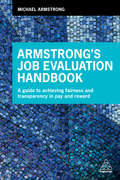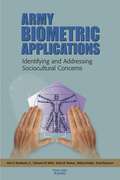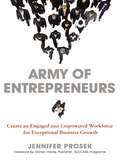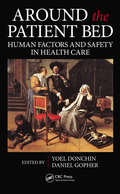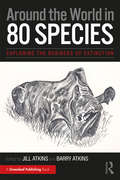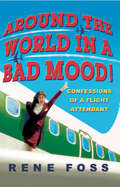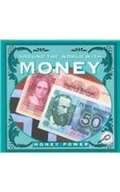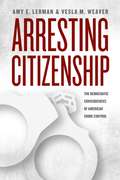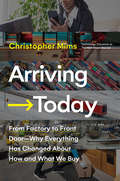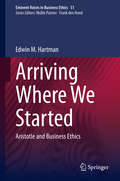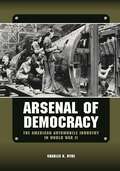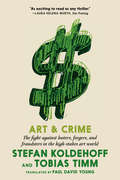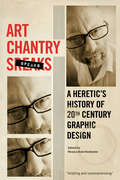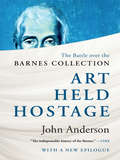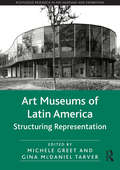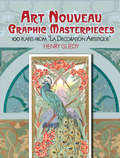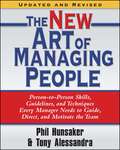- Table View
- List View
Armstrong's Job Evaluation Handbook: A Guide to Achieving Fairness and Transparency in Pay and Reward
by Michael ArmstrongJob evaluation is key to ensuring that employees are compensated fairly for their work. It is therefore essential that HR professionals have a robust process in place so that pay and reward are transparent and defensible within teams and across departments. Armstrong's Job Evaluation Handbook gives HR professionals all the tools they need to assess which approach to job evaluation is most suitable, how to implement it and how to maintain it. Packed with case studies from leading organizations such as Microsoft, Vodafone and the NHS, this guide will provide HR professionals with the ability to answer key questions such as how can we decide what is fair to pay our staff, how can we make sure that work of equal value receives equal pay and how can we make sure that our salaries remain competitive in the market?Armstrong's Job Evaluation Handbook covers everything needed to put effective job evaluation processes in place, including analytical matching and market pricing, developing job grades and defining pay structures. There is also coverage of the latest trends and issues in job evaluation, such as the decline in points-rated systems and the use of levelling by consultants. Underpinned by original research, this is a book that no HR department can afford to be without.
Army Biometric Applications: Identifying and Addressing Sociocultural Concerns
by Katharine Watkins Webb David Rubenson Elaine M. Newton John D. Woodward Melissa A. BradleyEvery human possesses more than one virtually infallible form of identification. Known as biometrics, examples include fingerprints, iris and retinal scans, hand geometry, and other measures of physical characteristics and personal traits. Advances in computers and related technologies have made this a highly automated process through which recognition occurs almost instantaneously. With concern about its information assurance systems and physical access control increasing, the Army has undertaken an assessment of how it can use biometrics to improve security, efficiency, and convenience. This report examines the sociocultural concerns that arise among soldiers, civilian employees, and the general public when the military mandates widespread use of biometrics. The authors see no significant legal obstacles to Army use of biometrics but recommend that the Army go beyond the provisions of the Privacy Act of 1974 to allay concerns related to this emerging technology. This report should be of interest to those responsible for access control as well as anyone concerned about privacy and technology issues.
Army Crew Team
by Scott A. Snook Jeffrey T. PolzerThe coach of the varsity Army crew team at West Point assembled his top eight rowers into the first crew team and the second tier of rowers into the second team using objective data on individual performance. As the second boat continually beat the first boat in races, the coach attempted to discern the team dynamics causing these aberrant results. By using very clean, objective performance data, the case makes clear that a team can be more (or less) than the sum of its individual parts, but allows students to analyze the factors that make this true.
Army of Entrepreneurs: Creating an Engaged and Empowered Workforce for Exceptional Business Growth
by Jennifer ProsekProsek (founder and CEO of a public relations firm) shares her secrets to creating a successful business. Her main point is that each employee must feel like the owner of the business, thus creating motivation and a positive attitude. Part one of the text introduces and discusses Prosek's business model. Part two tackles the mechanics of implementing her strategies into one's own business, such as training for all employees, and the use of technology. Part three offers a conclusion and a chapter devoted to addressing naysayers. An appendix listing additional resources is included. Annotation ©2011 Book News, Inc. , Portland, OR (booknews. com)
Arnold Palmer's Success Lessons: Wisdom On Golf, Business, And Life From The King Of Golf
by Brad BrewerArnold Palmer taught world-class pro golf instructor Brad Brewer how to play golf. But that was just the beginning. For more than 30 years, Palmer taught Brad how to live. As a businessman, a father, a celebrity, a philanthropist, and a friend, Palmer showed those around him that true success has nothing to do with the final score—and everything to do with how you play the game.In Arnold Palmer’s Success Lessons, Brad shares the life-changing truths he learned from the King of Golf throughout three decades of knowing Palmer as a business partner, employer, and mentor. In short but powerful chapters, Brad passes on Palmer’s secrets such as:Why you always need to play for the love of the gameWhat your starting point tells you about your destinationHow to capitalize on past successThe attitude of a true championWhy golf is like all the best things in life—it’s more complicated than it looksTaking us from Palmer’s childhood to his last years back in his own hometown, Brad introduces us to the Arnold Palmer behind the trophies, the celebrity, and the fame. This was the man who changed lives simply by living well, a man loved and respected not only for what he did but for who he was.
Around the Corner to Around the World: A Dozen Lessons I Learned Running Dunkin Donuts
by Robert RosenbergLearn twelve key lessons from Dunkin&’ Donuts former CEO Robert Rosenberg that offer critical insights and a unique, 360-degree perspective to business leaders and managers on building one of the world&’s most recognized brands.For entrepreneurs fighting for survival and leaders in growing businesses facing critical strategic decisions, competition is always fierce, and the future is never certain. Throughout all the chaos and the noise, you need a mentor that has seen a business through the ins and outs and can offer guidance that will exponentially tip the odds in your favor to succeed.Robert Rosenberg took over as CEO of Dunkin&’ Donuts in 1963, 13 years after the first restaurant was founded by his father, William. In his remarkable 35-year run, he grew the company from $10 million in sales to over $2 billion, with more than 3,000 outlets. Through his tenure, Robert learned important lessons on running and scaling a family business.In Around the Corner to Around the World, Rosenberg shares his insider perspective on all the dramatic highs and lows that are part of the Dunkin&’ Donuts story to guide you to your own success story.Around the Corner to Around the World: Distills the characteristics of a successful company through all phases of growth. Provides a new perspective on the dramatic story behind the rise of one of the world&’s most iconic brands.Tells the first-hand account (including essential lessons learned) from the tenure of one of the most successful CEO runs in modern business history.Reveals some of the dramatic and surprising plot turns in the story of Dunkin&’s rise to global prominence.
Around the Patient Bed: Human Factors and Safety in Health Care (Human Factors and Ergonomics)
by Yoel Donchin Daniel GopherThe occurrence of failures and mistakes in health care, from primary care procedures to the complexities of the operating room, has become a hot-button issue with the general public and within the medical community. Around the Patient Bed: Human Factors and Safety in Health Care examines the problem and investigates the tools to improve health care
Around the World in 80 Species: Exploring the Business of Extinction
by Jill Atkins Barry AtkinsThe world is currently experiencing a sixth period of mass species extinction, and extinction of flora and fauna is caused by a variety of factors arising from industrial activity and increasing human population, such as global warming, climate change, habitat loss, pollution and use of pesticides. Most causes of extinction are linked to corporate activity, either directly or indirectly. Around the World in 80 Species: Exploring the Business of Extinction responds to the ongoing mass extinction crisis engulfing our planet by exploring the ways in which accounting, business and finance can be used to prevent species extinctions. From Africa to the Far East and from Europe to the Americas, the authors explore species loss and how businesses can stop mass extinctions through greater transparency, and through closer engagement with their investors and wildlife organisations. The book concludes that global capitalism has led us to this extinction crisis and that therefore the mechanisms of capitalism – namely accounting, finance, investment – can help to pull us out. Businesses must urgently address extinction before it is too late for all species, including ourselves. As the first book to explore corporate accounting and accountability in relation to species on the brink of extinction, this book will be of great interest to both professionals and a wider audience interested in the causes and prevention of extinction.
Around the World in a Bad Mood!: Confessions of a Flight Attendant
by Rene FossThis hilarious book confronts every aspect of a flight attendant's absurd world--from the endless array of passenger demands, to the secret language of flight attendants, and a unique version of the Safety Demo Shuffle. Fasten your seatbelt and prepare yourself for a side-splitting perspective on the trials and tribulations of air travel.
Around the World with Money (Rourke Discovery Library)
by Jason CooperThis book discusses currency used around the world, featuring the money of the United States, Canada, Europe, Japan, and China
Arrested Development: The Soviet Union in Ghana, Guinea, and Mali, 1955–1968
by Alessandro IandoloArrested Development examines the USSR's involvement in West Africa during the 1950s and 1960s as aid donor, trade partner, and political inspiration for the first post-independence governments in Ghana, Guinea, and Mali. Buoyed by solid economic performance in the 1950s, the USSR opened itself up to the world and launched a series of programs aimed at supporting the search for economic development in newly independent countries in Africa and Asia. These countries, emerging from decades of colonial domination, looked at the USSR as an example to strengthen political and economic independence. Based on extensive research in Russian and West African archives, Alessandro Iandolo explores the ideas that guided Soviet engagement in West Africa, investigates the projects that the USSR sponsored "on the ground," and analyzes their implementation and legacy. The Soviet specialists who worked in Ghana, Guinea, and Mali collaborated with West African colleagues in drawing ambitious development plans, supervised the construction of new transport infrastructure, organized collective farms and fishing cooperatives, conducted geological surveys and mineral prospecting, set up banking systems, managed international trade, and staffed repairs workshops and ministerial bureaucracies alike. The exchanges and clashes born out of the encounter between Soviet and West African ideas, ambitions, and hopes about development reveal the USSR as a central actor in the history of economic development in the twentieth century.
Arresting Citizenship: The Democratic Consequences of American Crime Control (Chicago Studies In American Politics Ser.)
by Vesla M. Weaver Amy E. LermanThe numbers are staggering: One-third of America’s adult population has passed through the criminal justice system and now has a criminal record. Many more were never convicted, but are nonetheless subject to surveillance by the state. Never before has the American government maintained so vast a network of institutions dedicated solely to the control and confinement of its citizens. A provocative assessment of the contemporary carceral state for American democracy, Arresting Citizenship argues that the broad reach of the criminal justice system has fundamentally recast the relation between citizen and state, resulting in a sizable—and growing—group of second-class citizens. From police stops to court cases and incarceration, at each stage of the criminal justice system individuals belonging to this disempowered group come to experience a state-within-a-state that reflects few of the country’s core democratic values. Through scores of interviews, along with analyses of survey data, Amy E. Lerman and Vesla M. Weaver show how this contact with police, courts, and prisons decreases faith in the capacity of American political institutions to respond to citizens’ concerns and diminishes the sense of full and equal citizenship—even for those who have not been found guilty of any crime. The effects of this increasingly frequent contact with the criminal justice system are wide-ranging—and pernicious—and Lerman and Weaver go on to offer concrete proposals for reforms to reincorporate this large group of citizens as active participants in American civic and political life.
Arriving Today: From Factory to Front Door -- Why Everything Has Changed About How and What We Buy
by Christopher MimsThe Wall Street Journal technology columnist reveals the fascinating story behind the misleadingly simple phrase shoppers take for granted—“Arriving Today”—in this eye-opening investigation into the new rules of online commerce, transportation, and supply chain management.We are at a tipping point in retail history. While consumers are profiting from the convenience of instant gratification, rapidly advancing technologies are transforming the way goods are transported and displacing workers in ways never before seen.In Arriving Today, Christopher Mims goes deep, far, and wide to uncover how a single product, from creation to delivery, weaves its way from a factory on the other side of the world to our doorstep. He analyzes the evolving technologies and management strategies necessary to keep the product moving to fulfill consumers’ demand for “arriving today” gratification. Mims reveals a world where the only thing moving faster than goods in an Amazon warehouse is the rate at which an entire industry is being gutted and rebuilt by innovation and mass shifts in human labor practices. He goes behind the scenes to uncover the paradoxes in this shift—into the world’s busiest port, the cabin of an 18-wheeler, and Amazon’s automated warehouses—to explore how the promise of “arriving today” is fulfilled through a balletic dance between humans and machines. The scope of such large-scale innovation and expended energy is equal parts inspiring, enlightening, and horrifying. As he offers a glimpse of our future, Mims asks us to consider the system’s vulnerability and its resilience, and who shoulders the burden, as we hurtle toward a fully automated system—and what it will mean when we are there.
Arriving Where We Started: Aristotle and Business Ethics (Issues in Business Ethics #51)
by Edwin M. HartmanEdwin Hartman offers an account of his intellectual journey from Aristotle to organization theory to business ethics to an Aristotelian approach to business ethics. Aristotle’s work in metaphysics and psychology offers some insights into the explanation of behavior. Central to this sort of explanation is characteristically human rationality. Central to successful organizations is characteristically human sociability. That human beings are by nature rational and sociable is the basis of Aristotle’s ethics. Though a modern organization is not a polis in Aristotle’s sense, it has good reason to treat people as rational and sociable on the whole, and thereby to preserve the organization as a commons of people linked by something much like Aristotle’s account of strong friendship. Organizations that are successful in this respect, particularly those that deal with a nationally diverse workforce, may offer a far-reaching and attractive model.
Arrow Electronics, Inc.
by Das NarayandasDeals with the issue of cross-selling and managing a portfolio of products and services in business markets. Arrow/Schweber (A/S), a subsidiary of electronic parts distributor Arrow Electronics, has a portfolio of products that differ in the amount of value added by A/S. A/S uses value-added items such as programmable logic chips as "loss leaders" in order to acquire and retain a customer. It makes money when it sells the so-called "commodity" or low value-added products to the same customer. An Internet-based distributor is now offering Arrow a chance to sell commodity products through its e-commerce site. This new channel can threaten Arrow's overall business model if a large portion of its existing customers switch their purchases of the commodity products to this new distribution channel. Arrow needs to decide how it should respond to this challenge.
Arrow Electronics--The Apollo Acquistion
by Stephen P. KaufmanHaving already made 10 acquisitions of competitors in the last decade, the CEO of Arrow is evaluating the acquisition of another small competitor to boost sales, become #1 in a niche market segment, and achieve economies of scale. He is struggling with whether the deal makes strategic sense given forecasts that this niche segment is declining, whether the price is too high given the competitor's lack of profitability, and how to integrate the company into Arrow to maximize its value if he does the deal. Provides information to permit valuing the acquisition and developing a post-merger integration strategy and plan.
Arruinando al Tercer Mundo
by Marcela Gutiérrez Bravo y Luis Arturo Sánchez James Morcan Lance Morcan"Arruinando al Tercer Mundo" está dedicado a los pobres en lugares olvidados del mundo. Cuestiona si instituciones como el Banco Mundial, el Fondo Monetario Internacional, la Agencia de los Estados Unidos para el Desarrollo Internacional y otras grandes organizaciones de ayuda internacional en verdad rescatan o hunden a la gente más pobre del mundo. Este libro también cuestiona si la ayuda provista es genuina o si se trata de una estafa diseñada para subyugar a los países del Tercer Mundo. Expone la cultura de la corrupción dentro de las mencionadas organizaciones de ayuda y la arrogancia con que tratan a sus “clientes” del tercer mundo. Los Morcan revelan que hay una agenda oculta y vil en juego, donde la “generosidad” extendida por organizaciones de ayuda internacional para asistir al desarrollo del Tercer Mundo y proveer alivio en la eventualidad de desastres naturales no sea caridad, sino egoísmo, con varios hilos atados... hilos diseñados para esquilar naciones vulnerables. El lector encontrará al popular Sicario Económico John Perkins y encontrará que su bestseller “Confesiones de un Sicario Económico” es vigente, particularmente en África. Al escribir este libro, los autores fueron motivados por unas estadísticas escalofriantes: 21,000 personas mueres de hambre cada día. ¡Eso es una persona cada cuatro segundos! Más escalofriante es el hecho de que tales muertes son innecesarias, dado que hay más que suficiente riqueza en el mundo para que todos cubran, al menos, las necesidades básicas de la vida, y más que el Tercer Mundo se sostenga orgánicamente a sí mismo. Para cuando termines este libro, verás que hay tanta riqueza en el Tercer Mundo, como en el Primero. De hecho, términos como “Tercer Mundo” y “naciones pobres” están, esencialmente, equivocados, ya que implican que la riqueza y los recursos son limitados en estos lugares.
Arsenal of Democracy: The American Automobile Industry in World War II
by Charles K. HydeThroughout World War II, Detroit's automobile manufacturers accounted for one-fifth of the dollar value of the nation's total war production, and this amazing output from "the arsenal of democracy" directly contributed to the allied victory. In fact, automobile makers achieved such production miracles that many of their methods were adopted by other defense industries, particularly the aircraft industry. In Arsenal of Democracy: The American Automobile Industry in World War II, award-winning historian Charles K. Hyde details the industry's transition to a wartime production powerhouse and some of its notable achievements along the way. Hyde examines several innovative cooperative relationships that developed between the executive branch of the federal government, U.S. military services, automobile industry leaders, auto industry suppliers, and the United Automobile Workers (UAW) union, which set up the industry to achieve production miracles. He goes on to examine the struggles and achievements of individual automakers during the war years in producing items like aircraft engines, aircraft components, and complete aircraft; tanks and other armored vehicles; jeeps, trucks, and amphibians; guns, shells, and bullets of all types; and a wide range of other weapons and war goods ranging from search lights to submarine nets and gyroscopes. Hyde also considers the important role played by previously underused workers-namely African Americans and women-in the war effort and their experiences on the line. Arsenal of Democracy includes an analysis of wartime production nationally, on the automotive industry level, by individual automakers, and at the single plant level. For this thorough history, Hyde has consulted previously overlooked records collected by the Automobile Manufacturers Association that are now housed in the National Automotive History Collection of the Detroit Public Library. Automotive historians, World War II scholars, and American history buffs will welcome the compelling look at wartime industry in Arsenal of Democracy.
Art & Crime: The fight against looters, forgers, and fraudsters in the high-stakes art world
by Stefan Koldehoff Tobias TimmA thrilling, eye-popping look at true crime in the billion-dollar art world.The art world is one of the most secretive of global businesses, and the list of its crimes runs long and deep. Today, with prices in the hundreds of millions for individual artworks, and billionaires' collections among the most conspicuous and liquid of their assets, crime is more rampant than ever in this largely unregulated universe. Increased prices and globalization have introduced new levels of fraud and malfeasance into the art world--everything from "artnapping," in which an artwork is held hostage and only returned for a ransom, to forgery and tax fraud. However, the extent of the economic and cultural damage that results from criminality in the global art scene rarely comes to light. The stories of high-stakes, brazen art crimes told by art experts Stefan Koldehoff and Tobias Timm are by turns thrilling, disturbing, and unbelievable (the imagination for using art to commit crimes seems boundless). The authors also provide a well-founded analysis of what needs to change in the art market and at museums. From the authors of False Pictures, Real Money (about the Beltracchi art forgery case), Art and Crime includes a chapter on art owned by Donald Trump. It is a thoroughly researched, explosive, and highly topical book that uncovers the extraordinary and multifarious thefts of art and cultural objects around the world.
Art Chantry Speaks
by Art Chantry Monica René RochesterThere used to be a time when designers were trained in the history of composition. Now you just buy a fuckin' piece of software and now you've become a designer."Art Chantry . . . Is he a Luddite?" asks a Rhode Island School of Design poster promoting a Chantry lecture. "Or is he a graphic design hero?"For decades this avatar of low-tech design has fought against the cheap and easy use of digital software. Chantry's homage to expired technology, and his inspired use of Xerox machines and X-Acto blade cuts of printed material, created a much-copied style during the grunge period and beyond.Chantry's designs were published in Some People Can't Surf: The Graphic Design of Art Chantry (Chronicle Books), exhibited at the Seattle Art Museum, the Rock and Roll Hall of Fame, the Museum of Modern Art, the Smithsonian, and the Louvre.More recently, Chantry has drawn upon his extraordinary collection of twentieth-century graphic art to create compelling histories of the forgotten and unknown on essays he has posted on his Facebook page. These essays might lionize the unrecognized illustrators of screws, wrenches, and pipes in equipment catalogs. Other posts might reveal how some famous artists were improperly recognized.Art Chantry Speaks is the kind of opinionated art history you've always wanted to read but were never assigned.
Art Held Hostage: The Battle over the Barnes Collection
by John Anderson"Money, pretension, horrid behavior by cultured people" (New York) --John Anderson's tale delivers it all in fabulously juicy detail. This is the story of how a fabled art foundation--the greatest collection of impressionist and postimpressionist art in America, including 69 Cézannes, 60 Matisses, and 44 Picassos, among many priceless others--came to be, and how more than a decade of legal squabbling brought it to the brink of collapse and to a move that many believe betrayed the wishes of the founder, Dr. Albert C. Barnes (1872--1951). Art Held Hostage is now updated with a new epilogue by the author covering the current state of this international treasure and the endless battle over its fate.
Art Money Success: Finally Make a Living Doing What You Love
by Maria BrophyFINALLY MAKE A LIVING DOING WHAT YOU LOVE Why is it that some artists are wildly successful, while others just barely squeak by? It may seem like an unfathomable mystery, how some are earning six figures while other, more talented artists, are struggling. Maria Brophy has dedicated 20 years of her life to researching the specific strategies that successful artists follow. After applying these strategies to her husband Drew Brophy's career, Maria grew his art sales to multiple six-figures yearly. In ART MONEY SUCCESS, Maria tells personal stories of her own business deals, successes and failures, while sharing non-conventional wisdom that will explode your art sales. With the exercises and worksheets included, you can apply the insights to your own business for immediate results. The tools inside will help you: - Connect with your right buyers - Increase your $$$ income today - Sell art easily and negotiate nicely - License your art and get paid multiple times - Implement powerful money and business practices - Trust your own creative intuition If you are interested in generating more money and success from your art, then this book is for you! "A lot of people tell me that I should sell my work, but Maria Brophy is the first person who has been able to tell me how, in a viable way." -Joe Mahoney
Art Museums of Latin America: Structuring Representation (Routledge Research in Art Museums and Exhibitions)
by Michele Greet Gina McDaniel TarverSince the late nineteenth century, art museums have played crucial social, political, and economic roles throughout Latin America because of the ways that they structure representation. By means of their architecture, collections, exhibitions, and curatorial practices, Latin American art museums have crafted representations of communities, including nation states, and promoted particular group ideologies. This collection of essays, arranged in thematic sections, will examine the varying and complex functions of art museums in Latin America: as nation-building institutions and instruments of state cultural politics; as foci for the promotion of Latin American modernities and modernisms; as sites of mediation between local and international, private and public interests; as organizations that negotiate cultural construction within the Latin American diaspora and shape constructs of Latin America and its nations; and as venues for the contestation of elitist and Eurocentric notions of culture and the realization of cultural diversity rooted in multiethnic environments.
Art Nouveau Graphic Masterpieces: 100 Plates From "La Decoration Artistique" (Calla Editions)
by Henry GuedyPublished in Paris before World War I, these decorative Art Nouveau graphics originally appeared in a now-rare periodical, La Decoration Artistique. This compilation presents 100 full-color plates in a beautiful assortment of period designs that will prove essential to collectors of the era's best and hardest-to-find illustrations. A splendid variety of images includes headpieces, typographical banners, and other designs rendered in the distinctive Art Nouveau style, all embellished with naturalistic motifs, from parrots and peacocks to sinuous vines and flowers in full bloom. Other illustrations feature storefront signage for bakeries and cafés; decorative friezes of theatrical masks and grapevines; borders of blossoms, books, and birds; stenciled decorations for fire screens; and corner and ceiling ornaments. Art aficionados, designers, artists, art students, and anyone with a taste for Art Nouveau will delight in this extraordinary collection, which offers a lasting source of inspiration and pleasure.
Art Of Managing People
by Tony AlessandraThe Art of Managing People provides practical strategies, guidelines and techniques for developing an effective team of satisfied, energetic workers.
